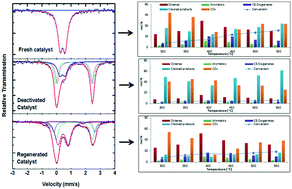Non oxidative and oxidative dehydrogenation of n-octane using FePO4: effect of different FePO4 phases on the product selectivity†
Abstract
The activation of n-octane with O2 has been investigated over different phases of FePO4 which were formed under dehydrogenation and oxidative dehydrogenation (ODH) conditions. Catalytic reactions were done with the tridymite-like FePO4 catalyst which showed a high selectivity towards cracked products and carbon oxides. Under dehydrogenation conditions, tridymite phase FePO4 is transformed into the iron pyrophosphate phase (Fe2P2O7). Octenes, aromatics, C8 oxygenates, carbon oxides (COx) and cracked products were present in the product stream. The iron pyrophosphate phase, under oxidative dehydrogenation conditions, showed high selectivity towards cracked products and on regeneration (restoring of the catalytic activity) with molecular oxygen it transformed into the α-phase and quartz type phase. The regenerated catalyst (α-phase and quartz type phase) exhibited a higher selectivity to ODH products when compared to the fresh and deactivated (Fe2P2O7) catalysts. The transformation of both fresh and deactivated catalysts was evident at a temperature of 450 °C. Since the α-phase is the active phase under ODH conditions and transformations between the reduced and α-phase take place reversibly, this could explain the highest selectivity towards octenes within this temperature range. Fresh and regenerated catalysts showed steady state conversions with time under constant conditions, showing that phase transformations were mainly due to varying temperature and oxidative environment. Characterization results show that FePO4 contains fivefold coordinate Fe3+ in the regenerated and fresh catalysts, and this species is believed to be responsible for selective n-octane activation. The surface area, acidity and metal dispersion of the deactivated and regenerated catalyst showed lower values when compared to the fresh catalysts. The results obtained from Mössbauer spectroscopy showed direct correlation with the XRD data as well as the TPR–TPO results in terms of the phase changes and oxidation state of the calcined, uncalcined, reduced and reoxidised catalyst.



 Please wait while we load your content...
Please wait while we load your content...